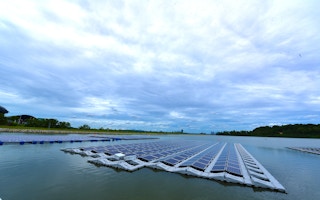Solar could meet as much as a quarter of Singapore’s energy demands by 2025, according to a white paper by the Sustainable Energy Association of Singapore (SEAS).
To continue reading, subscribe to Eco‑Business.
There's something for everyone. We offer a range of subscription plans.
- Access our stories and receive our Insights Weekly newsletter with the free EB Member plan.
- Unlock unlimited access to our content and archive with EB Circle.
- Publish your content with EB Premium.
This figure was noted by Deputy Prime Minister Teo Chee Hean in a speech to open Singapore International Energy Week (SIEW) on Monday.
He said that Singapore has the potential—without subsidies—to generate 2 gigawatts peak (GWp) of solar power in the next eight years.
The city-state currently generates 95 per cent of its 8 gigawatts of power from natural gas, and due to natural limitations has no potential for wind or hydropower—solar is Singapore’s only viable renewable energy option at present.
Singapore’s official solar target is 350 megawatts peak (MWp) by 2020, and 1 GWp “beyond 2020”.
The country’s current solar power capacity is 140 MWp, up from just 0.4 MWp in 2008. Peak power refers to the output achieved by a solar module under full solar radiation.
In a panel debate to discuss Singapore’s solar ambitions at the Asia Clean Energy Summit on Tuesday, Christophe Inglin, managing director of Singapore solar firm Energetix, said that hitting 2 GWp mark would be “no walk in the park, calculating that solar capacity in Singapore would need to double every two years to do so.
Aiming high
Singapore’s small size means that the city-state cannot rely only on land to scale up solar, noted Dr Thomas Reindl, deputy chief executive of Solar Energy Research Institute of Singapore (SERIS).
SERIS is studying how to convert the sides of skyscrapers into solar energy-producing panels, but it is floating solar technology that holds the potential to increase energy capacity quickly, Reindl noted.
He added that Singapore’s 17 reservoirs have the potential to generate about a half a gigawatt of electricity, and solar panels could also be placed at sea, as long as they’re close to shore where the water is calm and clear of shipping lanes.
The relocation of Singapore’s shipping port from Tanjong Pagar to Tuas could free up vital space for floating panels, Reindl noted.
However, he conceded that a phenomenon known as biofouling—that is, the accumulation of microorganisms on wet surfaces—is another consideration for offshore solar, as Singapore has some of the most biologically rich waters in the world.
“
If the framework is right, and if the economics work out, the speed of [solar] installation can be absolutely mind-blowing
Dr Thomas Reindl, deputy chief executive, Solar Energy Research Institute of Singapore
Monday’s announcement by the government included agreements for solar energy storage that will be vital to solve the problem of intermittency associated with renewable energy, as the city-state receives a lot of cloud cover.
Singapore has awarded deals to companies including Red Dot Power and CW Group to install 4.4 megawatt hours of storage solutions in sites connected to the grid.
The Energy Market Authority, Singapore’s energy regulator, also plans to make it easier for consumers to generate their own solar power and sell excess energy back to the grid, Sim Ann, senior minister of state for trade and ministry, told delegates on Monday.
The process of doing this will be simplified when Singapore’s energy market is liberalised in the second half of next year, enabling consumers to choose renewable energy to power their homes and participate in the energy market.
Though some at the event were sceptical that Singapore could reach 2 gigawatt-peak by 2025, Reindl offered some perspective by pointing out that China is now installing solar at a rate of 2.5 gigawatts per month.
“If the framework is right, and if the economics work out, the speed of installation can be absolutely mind-blowing,” he said.










